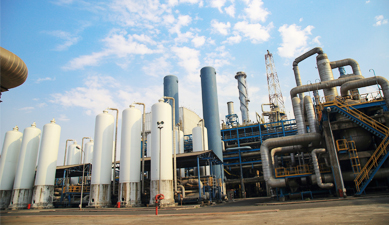Specifications
| Purity (Min.) | 99.5% |
| Oil (Max.) | 20 ppm |
| Moisture (Max.) | 1% |
| Anhydrous Ammonia conforms to | IS9747-1981 |
- In the manufacturing Ammonium Nitrate and Nitrite, Nitroglycerine, Tri-Nitrotoluene, Nitrocellulose and other Nitrogen Compounds used in the manufacturing of explosives.
- Manufacturing of chemicals like Methylamines, Monoethylamine, Melamine, Amino-Resins, Cynamides, Fertilizers, Petrochemical products, etc.
- As a refrigerant in both compression and absorption system. Certain characteristics of Ammonia such as high latent heat, low vapour density, chemical stability, low corrosion to iron parts promote its use in large industrial installations.
- In pulp and paper industry for pulping of wood and as a dispersant for casin in the coating of paper industry.
- In the metal industry for retaining of scrap metal. In the extraction of certain metals like Copper, Nickel, Molybdenum and Tungsten from their ores. In metal treating where cracked Ammonia is used as a reducing atmosphere for the bright annealing of Stainless Steels, Nickel and its alloys for reduction of metal oxides.
- Nitriding of steel for case-hardening.
- As a corrosion inhibitor at petroleum refineries and natural gas plant and to neutralise the acid constituents of oil, thereby protecting refinery equipment.
- In the rubber industry for the stabilisation of natural rubber and synthetic latex to prevent coagulation during transportation and storage.
- In food and beverages industries as a source of Nitrogen required for the growth of yeast and micro-organisms. Also for pH control in the yeast production. As ammoniating agent for glycerising, extractant, for bitter principles and source of Nitrogen for ruminant feeding when properly mixed with molasses.
- In leather industries as an airing agent in making leather and as a slime and mould in preventing tanning liquors, in the manufacturing of moth-proofing and other protective agents for furs and hides.
- Synthetic drugs manufacturing in pharmaceutical industry such as Sulphanilamide, Sulphathiazole, Sulphapyrridine and other Sulphfadrugs. Antibacterial agents, Vitamins, Antimalarial, Methionine and other Aminoacids and of Denitrifrices, lotions and cosmetics.
- In the manufacturing of household Ammonia detergents and cleansers.
- In combination with chlorine to purify industrial and municipal water supplies and as an Oxygen scavanger in treating boiler feed water.
- Ammonia blue printing
- In production of Nitrogen Dioxide required for converting Sulphur Dioxide in lead chamber process for manufacturing Sulphuric Acid.
- In Alkali industry in the production of Soda-Ash (Solvay process).
- In the manufacturing of Caprolactam, Urea etc.
- In the manufacturing of Rocket fuels.
- In the manufacturing of Nitric Acid, Liquor Ammonia.
- In the manufacturing of numerous organic and inorganic chemicals such as Cyanides, Amides, Nitrites and Dye Intermediates.
GSFC has a facility to fill up large Rail Tanker Wagons and Road Tankers.









